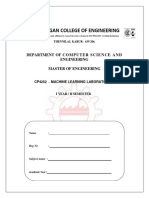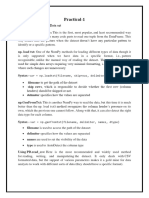0 ratings0% found this document useful (0 votes)
2 viewspractical assignment. applying methods of machine learning with example
The assignment aims to apply a Machine Learning model to a given dataset using a Jupyter notebook or Google Colab. It involves steps such as data visualization, preprocessing, model building, and performance evaluation, including confusion matrix analysis. The document provides a structured approach to analyze and predict outcomes based on the dataset.
Uploaded by
Maira KopzhasarovaCopyright
© © All Rights Reserved
Available Formats
Download as DOCX, PDF, TXT or read online on Scribd
0 ratings0% found this document useful (0 votes)
2 viewspractical assignment. applying methods of machine learning with example
The assignment aims to apply a Machine Learning model to a given dataset using a Jupyter notebook or Google Colab. It involves steps such as data visualization, preprocessing, model building, and performance evaluation, including confusion matrix analysis. The document provides a structured approach to analyze and predict outcomes based on the dataset.
Uploaded by
Maira KopzhasarovaCopyright
© © All Rights Reserved
Available Formats
Download as DOCX, PDF, TXT or read online on Scribd
You are on page 1/ 2
Objective of Assignment:
• To apply Machine Learning model for the given dataset.
• To prepare a jupyter notebook or Google Colab to build, train and evaluate a Machine
Learning models.
• To provide appropriate analysis for the same and do the prediction for the test data and
display the results.
Perform below step by step with python code considering above dataset
1. Import Libraries/Dataset
a. Download the dataset
b. Import the required libraries
2. Data Visualization and Exploration
a. Print at least 5 rows for sanity check to identify all the features present in the dataset
and if the target matches with them.
b. Print the description and shape of the dataset.
c. Provide appropriate visualization to get an insight about the dataset.
d. Try exploring the data and see what insights can be drawn from the dataset.
3. Data Pre-processing and cleaning
a. Do the appropriate preprocessing of the data like identifying NULL or Missing Values
if any, handling of outliers if present in the dataset, skewed data etc. Apply appropriate
feature engineering techniques for them.
b. Apply the feature transformation techniques like Standardization, Normalization, etc.
You are free to apply the appropriate transformations depending upon the structure and
the complexity of your dataset.
c. Do the correlational analysis on the dataset. Provide a visualization for the same.
4. Data Preparation
a. Do the final feature selection and extract them into Column X and the class label into
Column into Y.
b. Split the dataset into training and test sets.
5. Model Building
a. Perform Model Development.
b. Train the model and print the training accuracy and loss values.
6. Performance Evaluation
a. Print the confusion matrix. Provide appropriate analysis for the same.
b. Do the prediction for the test data and display the results.
Resources:
https://colab.research.google.com/drive/1t_duiR9B5FzYZkYmnw8SS6pSRXtYYj24?
usp=sharing
You might also like
- DATA MINING AND MACHINE LEARNING. PREDICTIVE TECHNIQUES: REGRESSION, GENERALIZED LINEAR MODELS, SUPPORT VECTOR MACHINE AND NEURAL NETWORKSFrom EverandDATA MINING AND MACHINE LEARNING. PREDICTIVE TECHNIQUES: REGRESSION, GENERALIZED LINEAR MODELS, SUPPORT VECTOR MACHINE AND NEURAL NETWORKSNo ratings yet
- A3 Classification and Feature EngineeringNo ratings yetA3 Classification and Feature Engineering2 pages
- Project - Machine Learning-Business Report: By: K Ravi Kumar PGP-Data Science and Business Analytics (PGPDSBA.O.MAR23.A)No ratings yetProject - Machine Learning-Business Report: By: K Ravi Kumar PGP-Data Science and Business Analytics (PGPDSBA.O.MAR23.A)38 pages
- How To Prepare Your Dataset For Machine Learning in PythonNo ratings yetHow To Prepare Your Dataset For Machine Learning in Python14 pages
- C2W3 Lab 01 Model Evaluation and SelectionNo ratings yetC2W3 Lab 01 Model Evaluation and Selection21 pages
- C2W3_Lab_01_Model_Evaluation_and_SelectionNo ratings yetC2W3_Lab_01_Model_Evaluation_and_Selection21 pages
- # ELG 5255 Applied Machine Learning Fall 2020 # Assignment 3 (Multivariate Method)No ratings yet# ELG 5255 Applied Machine Learning Fall 2020 # Assignment 3 (Multivariate Method)8 pages
- Salesforce Certified Platform Developer I CRT-450 Exam PreparationFrom EverandSalesforce Certified Platform Developer I CRT-450 Exam PreparationNo ratings yet
- School of Engineering: Lab Manual On Machine Learning LabNo ratings yetSchool of Engineering: Lab Manual On Machine Learning Lab23 pages
- Machine Learning Lab Assignment: InstructionsNo ratings yetMachine Learning Lab Assignment: Instructions4 pages



























































